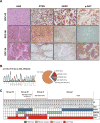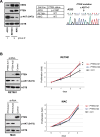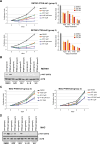Frequent PTEN loss and differential HER2/PI3K signaling pathway alterations in salivary duct carcinoma: Implications for targeted therapy
- PMID: 30289966
- PMCID: PMC6176717
- DOI: 10.1002/cncr.31600
Frequent PTEN loss and differential HER2/PI3K signaling pathway alterations in salivary duct carcinoma: Implications for targeted therapy
Abstract
Background: Patients with advanced primary and recurrent salivary duct carcinoma (SDC), a rare and lethal malignancy, have limited therapeutic options. Novel small-molecule agents aimed at targeting critical signaling associated with SDC tumorigenesis may lead to new therapeutic options for patients with these tumors. The human epidermal growth factor receptor 2 (HER2)/phosphoinositide 3-kinase (PI3K) axis, an important oncogenic pathway, has been targeted for therapy in several solid tumors. Currently, little is known about the role and clinical implications of alterations of the HER2/PI3K pathway in patients with SDC.
Methods: The authors investigated the clinicopathologic features, genetic alterations, and expression of key members of the HER2/PI3K pathway in 43 primary tumors and conducted in vitro functional and targeted drug-response analyses on cell lines derived from salivary epithelial carcinomas.
Results: In primary tumors, loss of phosphatase and tensin homolog (PTEN) expression was identified in 22 of 43 tumors (51%), overexpression of HER2 was observed in 12 of 43 tumors (28%), and phosphatidylinositol-4,5-bisphosphate 3-kinase catalytic subunit alpha (PIK3CA) mutations were identified in 12 of 43 tumors (28%). Phosphorylated protein kinase B (p-AKT) was highly expressed in most tumors. Most tumors (70%) displayed mutually exclusive alterations of PI3K members, whereas 8 tumors (19%) had 2 or more concurrent abnormalities. In vitro studies demonstrated a direct association between PTEN loss and PI3K pathway activation and evidence of response to combined PI3Kα and PI3Kβ and/or pan-PI3K inhibitors.
Conclusions: The current analyses reveal frequent PTEN loss and mutually exclusive alterations of key PI3K pathway members in SDC and demonstrate in vitro evidence of a response to pan-PI3K inhibitors. These results provide a framework for a biomarker-based substratification of patients with SDC in future targeted therapy. Cancer 2018;124:3523-32. © 2018 American Cancer Society.
Keywords: phosphatase and tensin homolog (PTEN) loss; phosphoinositide 3-kinase (PI3K) pathway; salivary duct carcinoma; salivary gland carcinoma; targeted therapy.
© 2018 American Cancer Society.
Conflict of interest statement
Figures





Similar articles
-
PIK3CA mutations and PTEN loss in salivary duct carcinomas.Am J Surg Pathol. 2013 Aug;37(8):1201-7. doi: 10.1097/PAS.0b013e3182880d5a. Am J Surg Pathol. 2013. PMID: 23851329
-
PI3K-p110α mediates resistance to HER2-targeted therapy in HER2+, PTEN-deficient breast cancers.Oncogene. 2016 Jul 7;35(27):3607-12. doi: 10.1038/onc.2015.406. Epub 2015 Oct 26. Oncogene. 2016. PMID: 26500061 Free PMC article.
-
Landscape of Phosphatidylinositol-3-Kinase Pathway Alterations Across 19 784 Diverse Solid Tumors.JAMA Oncol. 2016 Dec 1;2(12):1565-1573. doi: 10.1001/jamaoncol.2016.0891. JAMA Oncol. 2016. PMID: 27388585
-
Salivary duct carcinoma: Updates in histology, cytology, molecular biology, and treatment.Cancer Cytopathol. 2020 Oct;128(10):693-703. doi: 10.1002/cncy.22288. Epub 2020 May 18. Cancer Cytopathol. 2020. PMID: 32421944 Free PMC article. Review.
-
Mechanism of resistance to endocrine therapy in breast cancer: the important role of PI3K/Akt/mTOR in estrogen receptor-positive, HER2-negative breast cancer.Breast Cancer. 2018 Jul;25(4):392-401. doi: 10.1007/s12282-017-0812-x. Epub 2017 Oct 31. Breast Cancer. 2018. PMID: 29086897 Review.
Cited by
-
[Salivary gland malignancies-highlights of the 2019 ASCO Annual Meeting].HNO. 2019 Dec;67(12):931-934. doi: 10.1007/s00106-019-00760-9. HNO. 2019. PMID: 31628530 Review. German.
-
Targeted molecular profiling of salivary duct carcinoma with rhabdoid features highlights parallels to other apocrine and discohesive neoplasms: which phenotype should drive classification?Head Neck Pathol. 2022 Dec;16(4):1063-1072. doi: 10.1007/s12105-022-01464-3. Epub 2022 Jul 6. Head Neck Pathol. 2022. PMID: 35794510 Free PMC article.
-
Sclerosing Polycystic Adenoma: Conclusive Clinical and Molecular Evidence of Its Neoplastic Nature.Head Neck Pathol. 2022 Jun;16(2):416-426. doi: 10.1007/s12105-021-01374-w. Epub 2021 Aug 19. Head Neck Pathol. 2022. PMID: 34410594 Free PMC article.
-
A 10-year review of primary major salivary gland cancers.Ecancermedicalscience. 2020 Jun 12;14:1055. doi: 10.3332/ecancer.2020.1055. eCollection 2020. Ecancermedicalscience. 2020. PMID: 32582370 Free PMC article.
-
PTEN Deregulation Mechanisms in Salivary Gland Carcinomas.Cancer Diagn Progn. 2024 Jan 3;4(1):25-29. doi: 10.21873/cdp.10280. eCollection 2024 Jan-Feb. Cancer Diagn Progn. 2024. PMID: 38173659 Free PMC article. Review.
References
-
- Wee DT, Thomas AA, Bradley PJ. Salivary duct carcinoma: what is already known, and can we improve survival? J Laryngol Otol. 2012;126(Suppl 2):S2–7. - PubMed
-
- Murrah VA, Batsakis JG. Salivary duct carcinoma. Ann Otol Rhinol Laryngol. 1994;103:244–247. - PubMed
-
- Barnes L, Rao U, Krause J, Contis L, Schwartz A, Scalamogna P. Salivary duct carcinoma. Part I. A clinicopathologic evaluation and DNA image analysis of 13 cases with review of the literature. Oral Surg Oral Med Oral Pathol. 1994;78:64–73. - PubMed
-
- Simpson RH, Prasad AR, Lewis JE, Skalova A, David L. Mucin-rich variant of salivary duct carcinoma: a clinicopathologic and immunohistochemical study of four cases. Am J Surg Pathol. 2003;27:1070–1079. - PubMed
-
- Yakirevich E, Sabo E, Klorin G, et al. Primary mucin-producing tumours of the salivary glands: a clinicopathological and morphometric study. Histopathology. 2010;57:395–409. - PubMed
Publication types
MeSH terms
Substances
Grants and funding
LinkOut - more resources
Full Text Sources
Medical
Research Materials
Miscellaneous

